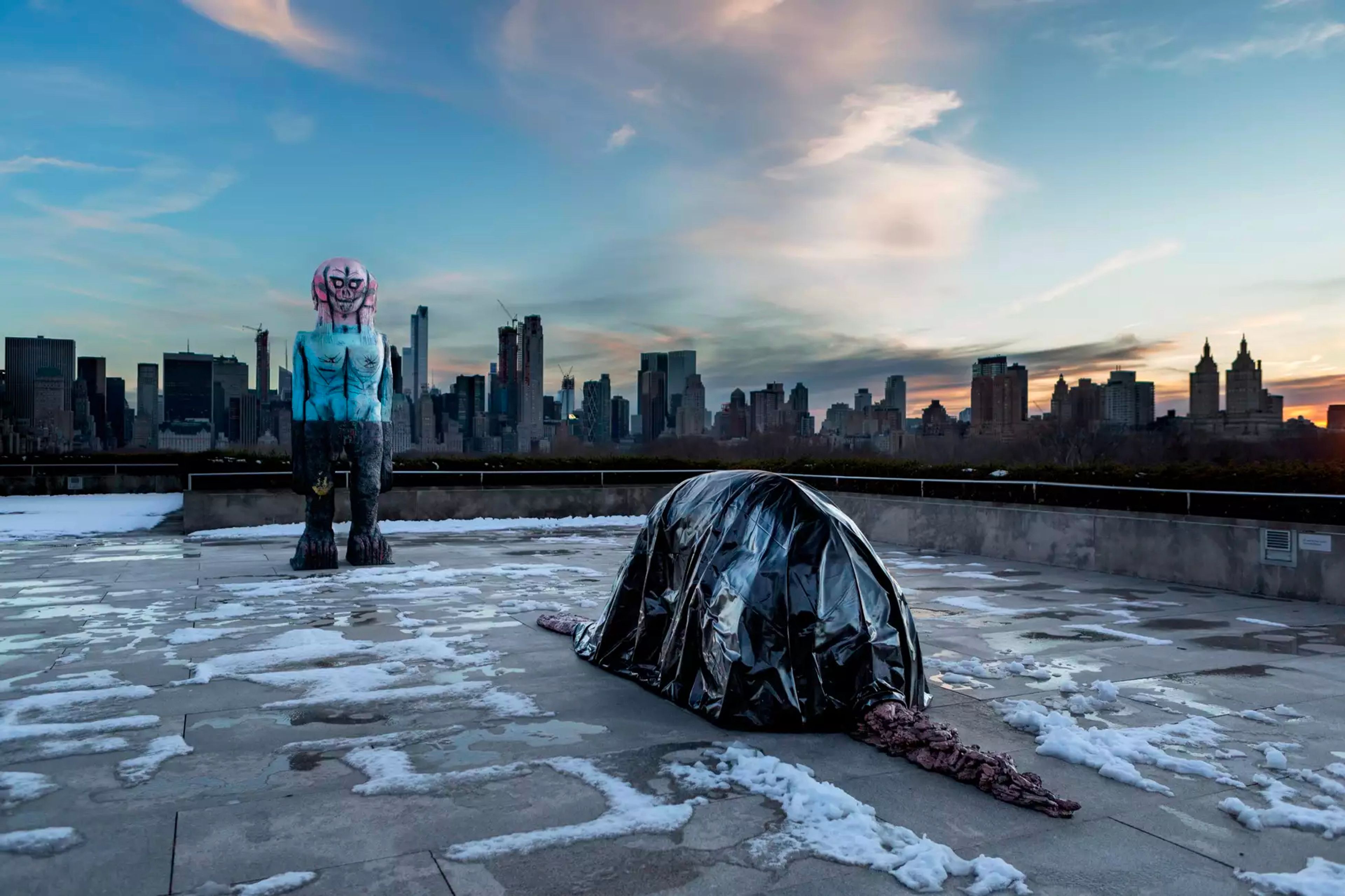April 2022
April 13, 2022 – David Zwirner is pleased to announce the representation of Huma Bhabha. The gallery will present new work by the artist in New York in 2024. Bhabha will continue to work on special projects with Jeanne Greenberg Rohatyn, and will continue to be represented by David Kordansky Gallery in Los Angeles and Xavier Hufkens in Brussels. Since the 1990s, Bhabha has become known for layered and nuanced work that centers on a reinvention of the figure and its expressive possibilities. In her formally inventive practice, which encompasses sculpture, drawings, and photography, Bhabha draws from a wide range of references, from those that span the history of art—including Egyptian reliquaries, African sculpture, Greek kouroi, Gandharan Buddhas, as well as the work of such modern and contemporary artists as Joseph Beuys, Louise Bourgeois, Alberto Giacometti, Robert Rauschenberg, and Franz West, among others—to quotidian influences such as science fiction and horror films and the makeshift structures and detritus of urban life. Employing found materials including Styrofoam, plastic bags, cork, scavenged wood, clay, and paint, in addition to traditional materials such as bronze, she builds around a central armature in an additive process before carving, modeling, gouging, painting, or otherwise marking the surfaces of her sculptures. Bhabha combines and transforms her materials into profoundly resonant hybrid forms in which the past, present, and future coalesce. At once monstrous, animal, alien, and deeply human, her totemic figures hover between states of ruin and repair, recalling cycles of growth and decay, destruction and restoration, thereby challenging our understanding of permanence and monumentality and of personal and collective histories. As curator Shanay Jhaveri writes, “The artist’s roving eye speaks volumes to a particular sensibility, one in which various aesthetic practices are in dialogue with one another. Her perpetual sensitivity to multiple frames of reference is both intuitive and intentional.… There is a convergence of form and content in her work, coming from different places and histories, that seeks to question rather than affirm extant cultural dynamics.” David Zwirner stated, “Huma Bhabha’s art making has always struck me as truly singular. Her formal references, which can take you back to the very beginning of sculpture as well as into the future, are often jarring and dissonant, yet always project an otherworldly beauty. I find it fascinating that discussions around aesthetics have been moving ever more in her direction in recent years, and, increasingly, her practice feels like it will be central for our times. I’m honored that Huma has decided to join our gallery.” Jeanne Greenberg Rohatyn added, “Working with Huma Bhabha over the past fifteen years has been a great privilege. She is part of the Salon 94 DNA and her museum and gallery exhibitions are among our proudest moments. As I transition to LGDR, and Huma moves representation, I look forward to a continued collaboration with her and Zwirner on special projects.” Huma Bhabha was born in Karachi, Pakistan, in 1962 and moved to the United States in 1981 to attend Rhode Island School of Design, Providence, from which she received her BFA in 1985. She later studied at the School of the Arts at Columbia University, New York, from which she received her MFA in 1989. The artist presently lives and works in Poughkeepsie, New York. A solo presentation of Bhabha’s work curated by Nicholas Baume is currently on view at Fundación Casa Wabi, Puerto Escondido, Mexico, through January 2023. In 2020, the Baltic Centre for Contemporary Art, Gateshead, England, presented Huma Bhabha: Against Time. The Institute of Contemporary Art, Boston, organized Huma Bhabha: They Live, on view in 2019, and published an accompanying catalogue. An installation of the artist’s work, Huma Bhabha: We Come in Peace, was commissioned by The Metropolitan Museum of Art, New York, in 2018 for their roof garden. Previous solo exhibitions have taken place at prominent institutions such as The Contemporary Austin, Texas (2018); MoMA PS1, Long Island City, New York (2012); Collezione Maramotti, Reggio Emilia, Italy (2012); Aspen Art Museum, Colorado (2011); and The Aldrich Contemporary Art Museum, Ridgefield, Connecticut (2008), among others. Bhabha’s work has also been included in numerous group exhibitions internationally, including the 2019 Yorkshire Sculpture International, Wakefield, United Kingdom; the 56th Venice Biennale, All the World’s Futures (2015); and the 2010 Whitney Biennial. Bhabha has been the recipient of notable awards, such as The American Academy in Berlin’s Berlin Prize, the Guna S. Mundheim Fellowship (2013), and the Emerging Artist Award from The Aldrich Contemporary Art Museum, Ridgefield, Connecticut (2008). Work by the artist is held in collections worldwide, including the Albright-Knox Art Gallery, Buffalo, New York; The Art Gallery of New South Wales, Sydney, Australia; The Bronx Museum of Art, New York; Carnegie Museum of Art, Pittsburgh; Centre Georges Pompidou, Paris; Collezione Maramotti, Reggio Emilia, Italy; Frances Lehman Loeb Art Center, Vassar College, Poughkeepsie, New York; Hammer Museum, Los Angeles; Hirshhorn Museum and Sculpture Garden, Washington, DC; Long Museum, Shanghai; Los Angeles County Museum of Art; The Metropolitan Museum of Art, New York; Museum of Art, University of New Hampshire, Durham; Museum of Fine Arts, Houston; The Museum of Modern Art, New York; Museum of Old and New Art, Hobart, Tasmania, Australia; National Gallery of Australia, Canberra; Nerman Museum of Contemporary Art, Overland Park, Kansas; The New York Public Library; RISD Museum, Providence, Rhode Island; The Roberts Institute of Art, London; Sharjah Art Foundation, United Arab Emirates; Sheldon Museum of Art, University of Nebraska, Lincoln; Tate Modern, London; Whitney Museum of American Art, New York; Yale University Art Gallery, New Haven, Connecticut; and the Zhuzhong Art Museum, Beijing, among others. Read more at ARTnews. For all press inquiries, contact Julia Lukacher +1 212 727 2070 jlukacher@davidzwirner.com

